Strategic Analysis: Evaluating PESTEL, SWOT, and Porter’s Five Forces
VerifiedAdded on 2023/06/13
|6
|1684
|181
Essay
AI Summary
This essay provides a comprehensive analysis of competitive strategy using the PESTEL framework, SWOT analysis, and Porter’s Five Forces model. It evaluates how these models assess factors influencing a company's operations and profitability, enabling management to create strategic policies aligned with organizational goals. The essay examines each model, detailing their components, such as political, economic, social, technological, environmental, and legal factors in PESTEL; strengths, weaknesses, opportunities, and threats in SWOT; and bargaining power of suppliers and buyers, the threat of new entrants and substitutes, and competitive rivalry in Porter’s Five Forces. Practical examples, including Amazon and Zara, illustrate the application of these frameworks in real-world scenarios, demonstrating how companies like Amazon use PESTEL to navigate external influences and how Zara leverages SWOT to maintain a competitive edge through its efficient supply chain. The essay concludes that these frameworks are essential tools for management to make informed strategic decisions, improve efficiency, and sustain future growth by evaluating both internal and external factors.
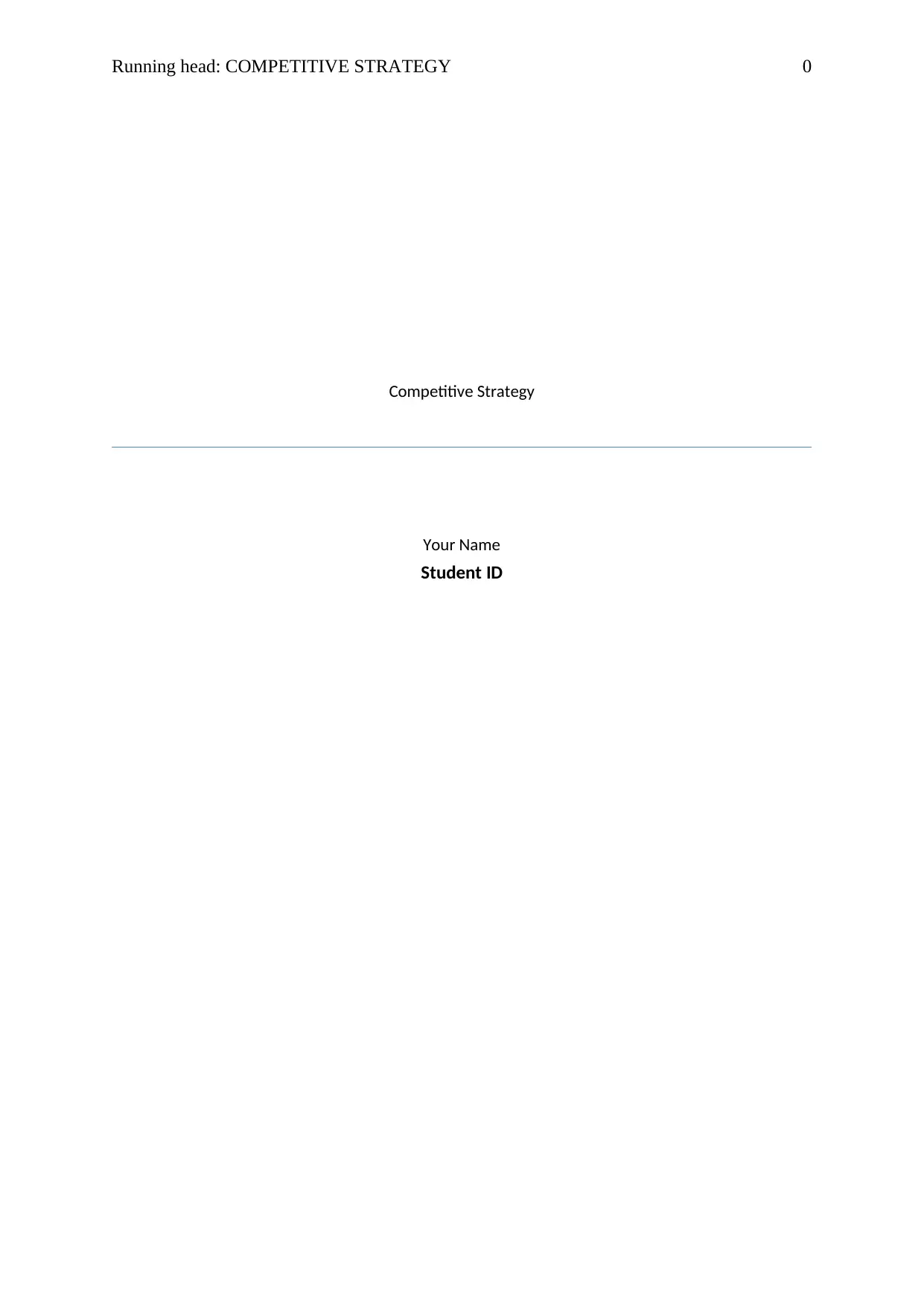
Running head: COMPETITIVE STRATEGY 0
Competitive Strategy
Your Name
Student ID
Competitive Strategy
Your Name
Student ID
Paraphrase This Document
Need a fresh take? Get an instant paraphrase of this document with our AI Paraphraser
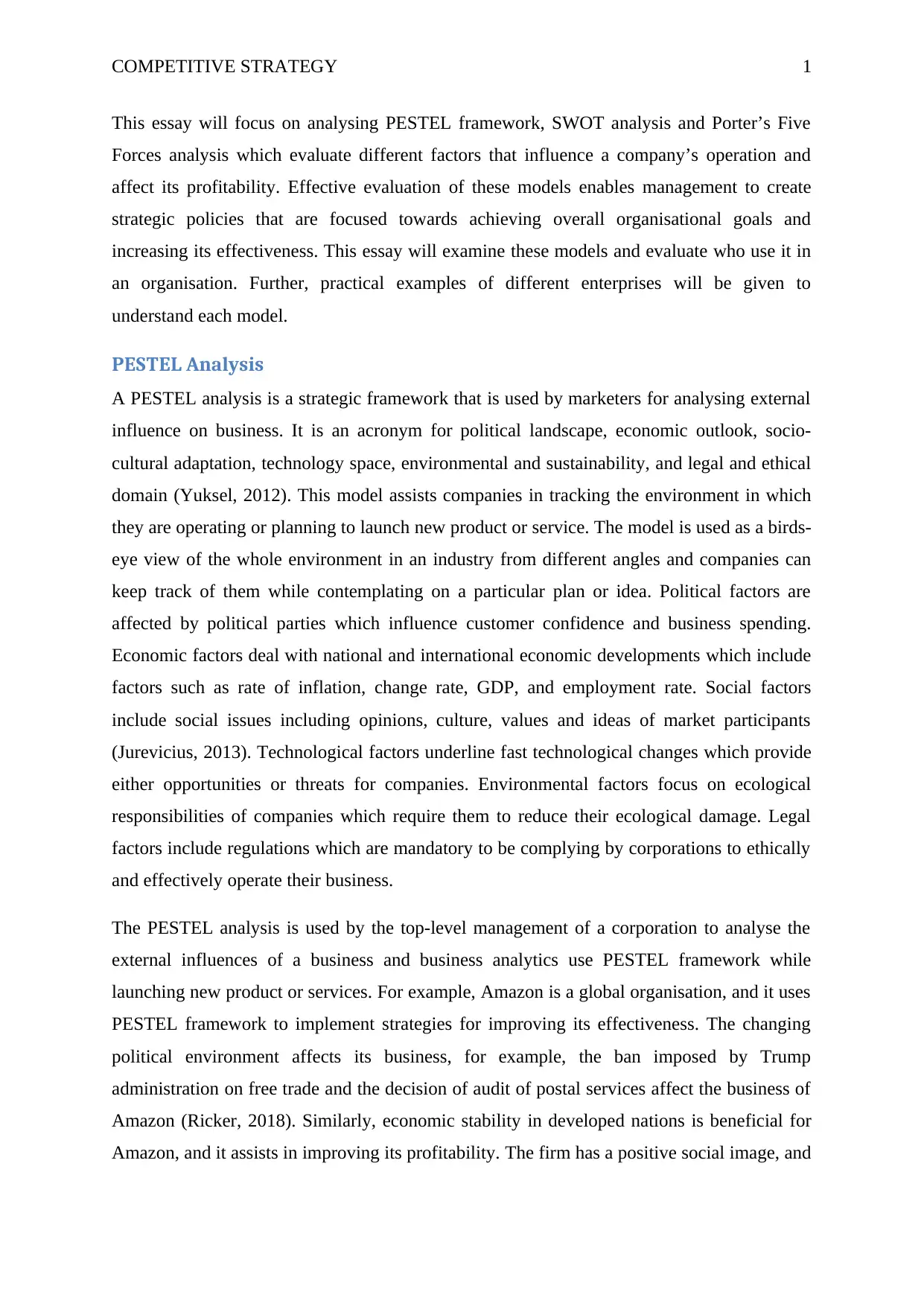
COMPETITIVE STRATEGY 1
This essay will focus on analysing PESTEL framework, SWOT analysis and Porter’s Five
Forces analysis which evaluate different factors that influence a company’s operation and
affect its profitability. Effective evaluation of these models enables management to create
strategic policies that are focused towards achieving overall organisational goals and
increasing its effectiveness. This essay will examine these models and evaluate who use it in
an organisation. Further, practical examples of different enterprises will be given to
understand each model.
PESTEL Analysis
A PESTEL analysis is a strategic framework that is used by marketers for analysing external
influence on business. It is an acronym for political landscape, economic outlook, socio-
cultural adaptation, technology space, environmental and sustainability, and legal and ethical
domain (Yuksel, 2012). This model assists companies in tracking the environment in which
they are operating or planning to launch new product or service. The model is used as a birds-
eye view of the whole environment in an industry from different angles and companies can
keep track of them while contemplating on a particular plan or idea. Political factors are
affected by political parties which influence customer confidence and business spending.
Economic factors deal with national and international economic developments which include
factors such as rate of inflation, change rate, GDP, and employment rate. Social factors
include social issues including opinions, culture, values and ideas of market participants
(Jurevicius, 2013). Technological factors underline fast technological changes which provide
either opportunities or threats for companies. Environmental factors focus on ecological
responsibilities of companies which require them to reduce their ecological damage. Legal
factors include regulations which are mandatory to be complying by corporations to ethically
and effectively operate their business.
The PESTEL analysis is used by the top-level management of a corporation to analyse the
external influences of a business and business analytics use PESTEL framework while
launching new product or services. For example, Amazon is a global organisation, and it uses
PESTEL framework to implement strategies for improving its effectiveness. The changing
political environment affects its business, for example, the ban imposed by Trump
administration on free trade and the decision of audit of postal services affect the business of
Amazon (Ricker, 2018). Similarly, economic stability in developed nations is beneficial for
Amazon, and it assists in improving its profitability. The firm has a positive social image, and
This essay will focus on analysing PESTEL framework, SWOT analysis and Porter’s Five
Forces analysis which evaluate different factors that influence a company’s operation and
affect its profitability. Effective evaluation of these models enables management to create
strategic policies that are focused towards achieving overall organisational goals and
increasing its effectiveness. This essay will examine these models and evaluate who use it in
an organisation. Further, practical examples of different enterprises will be given to
understand each model.
PESTEL Analysis
A PESTEL analysis is a strategic framework that is used by marketers for analysing external
influence on business. It is an acronym for political landscape, economic outlook, socio-
cultural adaptation, technology space, environmental and sustainability, and legal and ethical
domain (Yuksel, 2012). This model assists companies in tracking the environment in which
they are operating or planning to launch new product or service. The model is used as a birds-
eye view of the whole environment in an industry from different angles and companies can
keep track of them while contemplating on a particular plan or idea. Political factors are
affected by political parties which influence customer confidence and business spending.
Economic factors deal with national and international economic developments which include
factors such as rate of inflation, change rate, GDP, and employment rate. Social factors
include social issues including opinions, culture, values and ideas of market participants
(Jurevicius, 2013). Technological factors underline fast technological changes which provide
either opportunities or threats for companies. Environmental factors focus on ecological
responsibilities of companies which require them to reduce their ecological damage. Legal
factors include regulations which are mandatory to be complying by corporations to ethically
and effectively operate their business.
The PESTEL analysis is used by the top-level management of a corporation to analyse the
external influences of a business and business analytics use PESTEL framework while
launching new product or services. For example, Amazon is a global organisation, and it uses
PESTEL framework to implement strategies for improving its effectiveness. The changing
political environment affects its business, for example, the ban imposed by Trump
administration on free trade and the decision of audit of postal services affect the business of
Amazon (Ricker, 2018). Similarly, economic stability in developed nations is beneficial for
Amazon, and it assists in improving its profitability. The firm has a positive social image, and
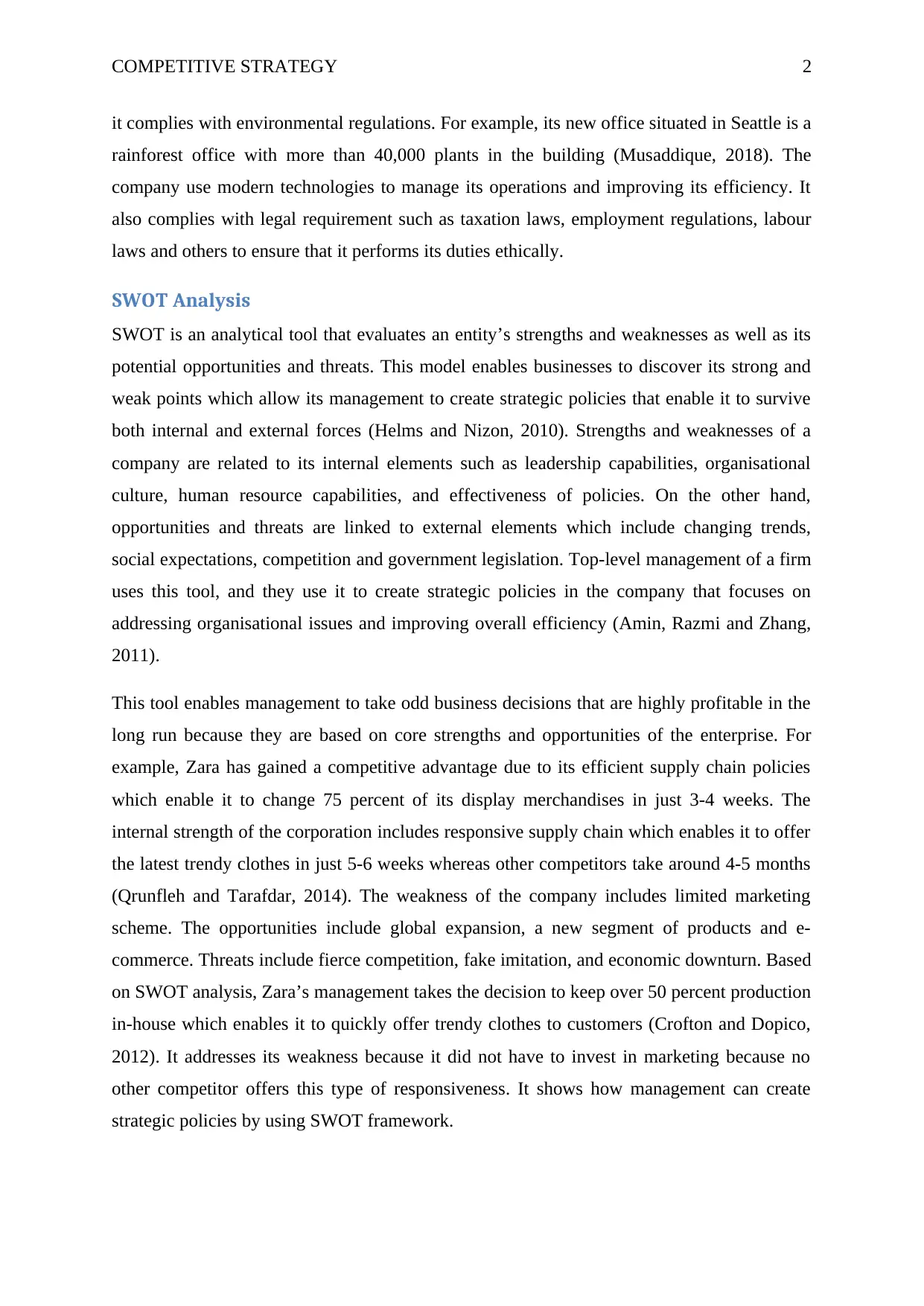
COMPETITIVE STRATEGY 2
it complies with environmental regulations. For example, its new office situated in Seattle is a
rainforest office with more than 40,000 plants in the building (Musaddique, 2018). The
company use modern technologies to manage its operations and improving its efficiency. It
also complies with legal requirement such as taxation laws, employment regulations, labour
laws and others to ensure that it performs its duties ethically.
SWOT Analysis
SWOT is an analytical tool that evaluates an entity’s strengths and weaknesses as well as its
potential opportunities and threats. This model enables businesses to discover its strong and
weak points which allow its management to create strategic policies that enable it to survive
both internal and external forces (Helms and Nizon, 2010). Strengths and weaknesses of a
company are related to its internal elements such as leadership capabilities, organisational
culture, human resource capabilities, and effectiveness of policies. On the other hand,
opportunities and threats are linked to external elements which include changing trends,
social expectations, competition and government legislation. Top-level management of a firm
uses this tool, and they use it to create strategic policies in the company that focuses on
addressing organisational issues and improving overall efficiency (Amin, Razmi and Zhang,
2011).
This tool enables management to take odd business decisions that are highly profitable in the
long run because they are based on core strengths and opportunities of the enterprise. For
example, Zara has gained a competitive advantage due to its efficient supply chain policies
which enable it to change 75 percent of its display merchandises in just 3-4 weeks. The
internal strength of the corporation includes responsive supply chain which enables it to offer
the latest trendy clothes in just 5-6 weeks whereas other competitors take around 4-5 months
(Qrunfleh and Tarafdar, 2014). The weakness of the company includes limited marketing
scheme. The opportunities include global expansion, a new segment of products and e-
commerce. Threats include fierce competition, fake imitation, and economic downturn. Based
on SWOT analysis, Zara’s management takes the decision to keep over 50 percent production
in-house which enables it to quickly offer trendy clothes to customers (Crofton and Dopico,
2012). It addresses its weakness because it did not have to invest in marketing because no
other competitor offers this type of responsiveness. It shows how management can create
strategic policies by using SWOT framework.
it complies with environmental regulations. For example, its new office situated in Seattle is a
rainforest office with more than 40,000 plants in the building (Musaddique, 2018). The
company use modern technologies to manage its operations and improving its efficiency. It
also complies with legal requirement such as taxation laws, employment regulations, labour
laws and others to ensure that it performs its duties ethically.
SWOT Analysis
SWOT is an analytical tool that evaluates an entity’s strengths and weaknesses as well as its
potential opportunities and threats. This model enables businesses to discover its strong and
weak points which allow its management to create strategic policies that enable it to survive
both internal and external forces (Helms and Nizon, 2010). Strengths and weaknesses of a
company are related to its internal elements such as leadership capabilities, organisational
culture, human resource capabilities, and effectiveness of policies. On the other hand,
opportunities and threats are linked to external elements which include changing trends,
social expectations, competition and government legislation. Top-level management of a firm
uses this tool, and they use it to create strategic policies in the company that focuses on
addressing organisational issues and improving overall efficiency (Amin, Razmi and Zhang,
2011).
This tool enables management to take odd business decisions that are highly profitable in the
long run because they are based on core strengths and opportunities of the enterprise. For
example, Zara has gained a competitive advantage due to its efficient supply chain policies
which enable it to change 75 percent of its display merchandises in just 3-4 weeks. The
internal strength of the corporation includes responsive supply chain which enables it to offer
the latest trendy clothes in just 5-6 weeks whereas other competitors take around 4-5 months
(Qrunfleh and Tarafdar, 2014). The weakness of the company includes limited marketing
scheme. The opportunities include global expansion, a new segment of products and e-
commerce. Threats include fierce competition, fake imitation, and economic downturn. Based
on SWOT analysis, Zara’s management takes the decision to keep over 50 percent production
in-house which enables it to quickly offer trendy clothes to customers (Crofton and Dopico,
2012). It addresses its weakness because it did not have to invest in marketing because no
other competitor offers this type of responsiveness. It shows how management can create
strategic policies by using SWOT framework.
⊘ This is a preview!⊘
Do you want full access?
Subscribe today to unlock all pages.

Trusted by 1+ million students worldwide
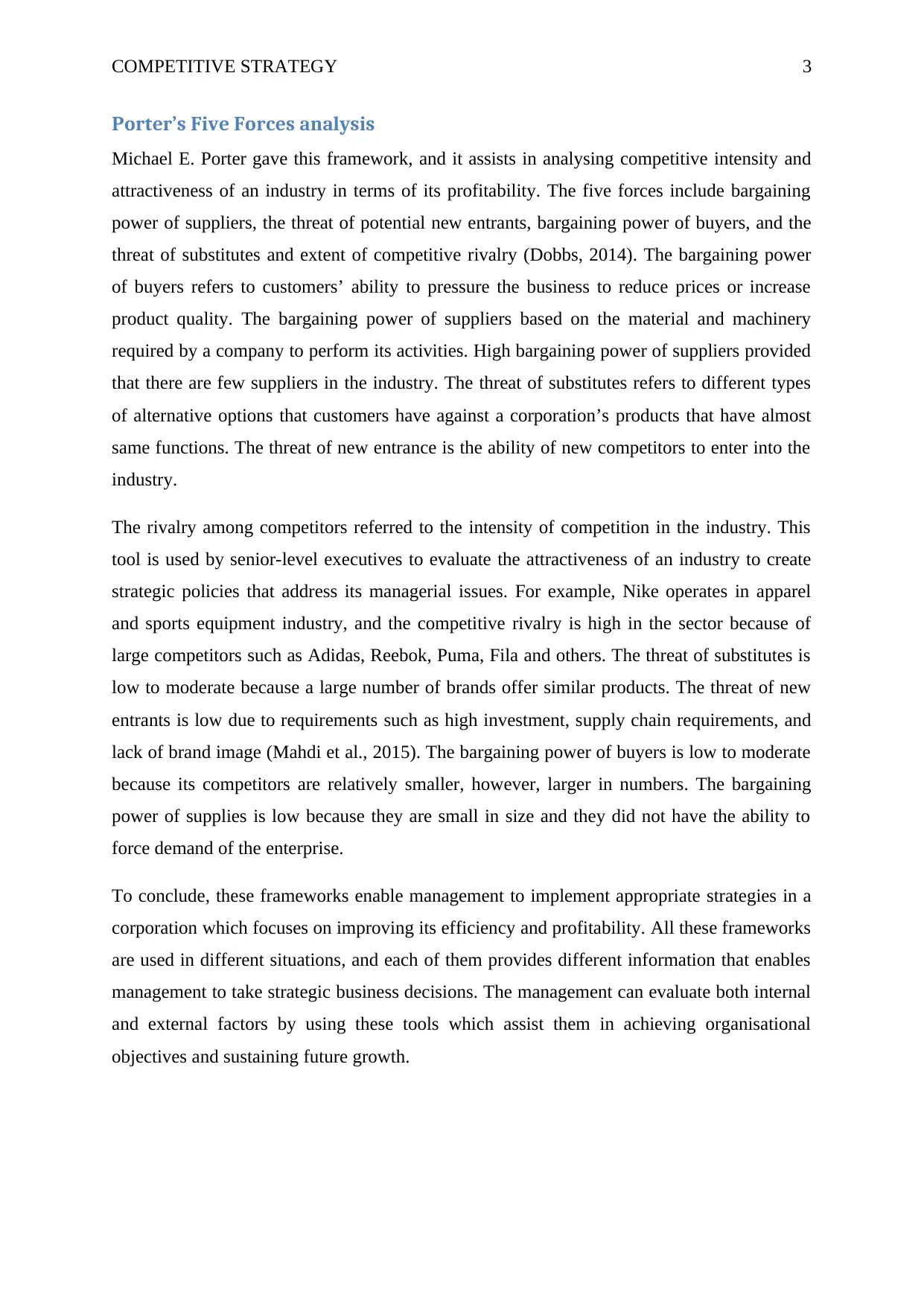
COMPETITIVE STRATEGY 3
Porter’s Five Forces analysis
Michael E. Porter gave this framework, and it assists in analysing competitive intensity and
attractiveness of an industry in terms of its profitability. The five forces include bargaining
power of suppliers, the threat of potential new entrants, bargaining power of buyers, and the
threat of substitutes and extent of competitive rivalry (Dobbs, 2014). The bargaining power
of buyers refers to customers’ ability to pressure the business to reduce prices or increase
product quality. The bargaining power of suppliers based on the material and machinery
required by a company to perform its activities. High bargaining power of suppliers provided
that there are few suppliers in the industry. The threat of substitutes refers to different types
of alternative options that customers have against a corporation’s products that have almost
same functions. The threat of new entrance is the ability of new competitors to enter into the
industry.
The rivalry among competitors referred to the intensity of competition in the industry. This
tool is used by senior-level executives to evaluate the attractiveness of an industry to create
strategic policies that address its managerial issues. For example, Nike operates in apparel
and sports equipment industry, and the competitive rivalry is high in the sector because of
large competitors such as Adidas, Reebok, Puma, Fila and others. The threat of substitutes is
low to moderate because a large number of brands offer similar products. The threat of new
entrants is low due to requirements such as high investment, supply chain requirements, and
lack of brand image (Mahdi et al., 2015). The bargaining power of buyers is low to moderate
because its competitors are relatively smaller, however, larger in numbers. The bargaining
power of supplies is low because they are small in size and they did not have the ability to
force demand of the enterprise.
To conclude, these frameworks enable management to implement appropriate strategies in a
corporation which focuses on improving its efficiency and profitability. All these frameworks
are used in different situations, and each of them provides different information that enables
management to take strategic business decisions. The management can evaluate both internal
and external factors by using these tools which assist them in achieving organisational
objectives and sustaining future growth.
Porter’s Five Forces analysis
Michael E. Porter gave this framework, and it assists in analysing competitive intensity and
attractiveness of an industry in terms of its profitability. The five forces include bargaining
power of suppliers, the threat of potential new entrants, bargaining power of buyers, and the
threat of substitutes and extent of competitive rivalry (Dobbs, 2014). The bargaining power
of buyers refers to customers’ ability to pressure the business to reduce prices or increase
product quality. The bargaining power of suppliers based on the material and machinery
required by a company to perform its activities. High bargaining power of suppliers provided
that there are few suppliers in the industry. The threat of substitutes refers to different types
of alternative options that customers have against a corporation’s products that have almost
same functions. The threat of new entrance is the ability of new competitors to enter into the
industry.
The rivalry among competitors referred to the intensity of competition in the industry. This
tool is used by senior-level executives to evaluate the attractiveness of an industry to create
strategic policies that address its managerial issues. For example, Nike operates in apparel
and sports equipment industry, and the competitive rivalry is high in the sector because of
large competitors such as Adidas, Reebok, Puma, Fila and others. The threat of substitutes is
low to moderate because a large number of brands offer similar products. The threat of new
entrants is low due to requirements such as high investment, supply chain requirements, and
lack of brand image (Mahdi et al., 2015). The bargaining power of buyers is low to moderate
because its competitors are relatively smaller, however, larger in numbers. The bargaining
power of supplies is low because they are small in size and they did not have the ability to
force demand of the enterprise.
To conclude, these frameworks enable management to implement appropriate strategies in a
corporation which focuses on improving its efficiency and profitability. All these frameworks
are used in different situations, and each of them provides different information that enables
management to take strategic business decisions. The management can evaluate both internal
and external factors by using these tools which assist them in achieving organisational
objectives and sustaining future growth.
Paraphrase This Document
Need a fresh take? Get an instant paraphrase of this document with our AI Paraphraser
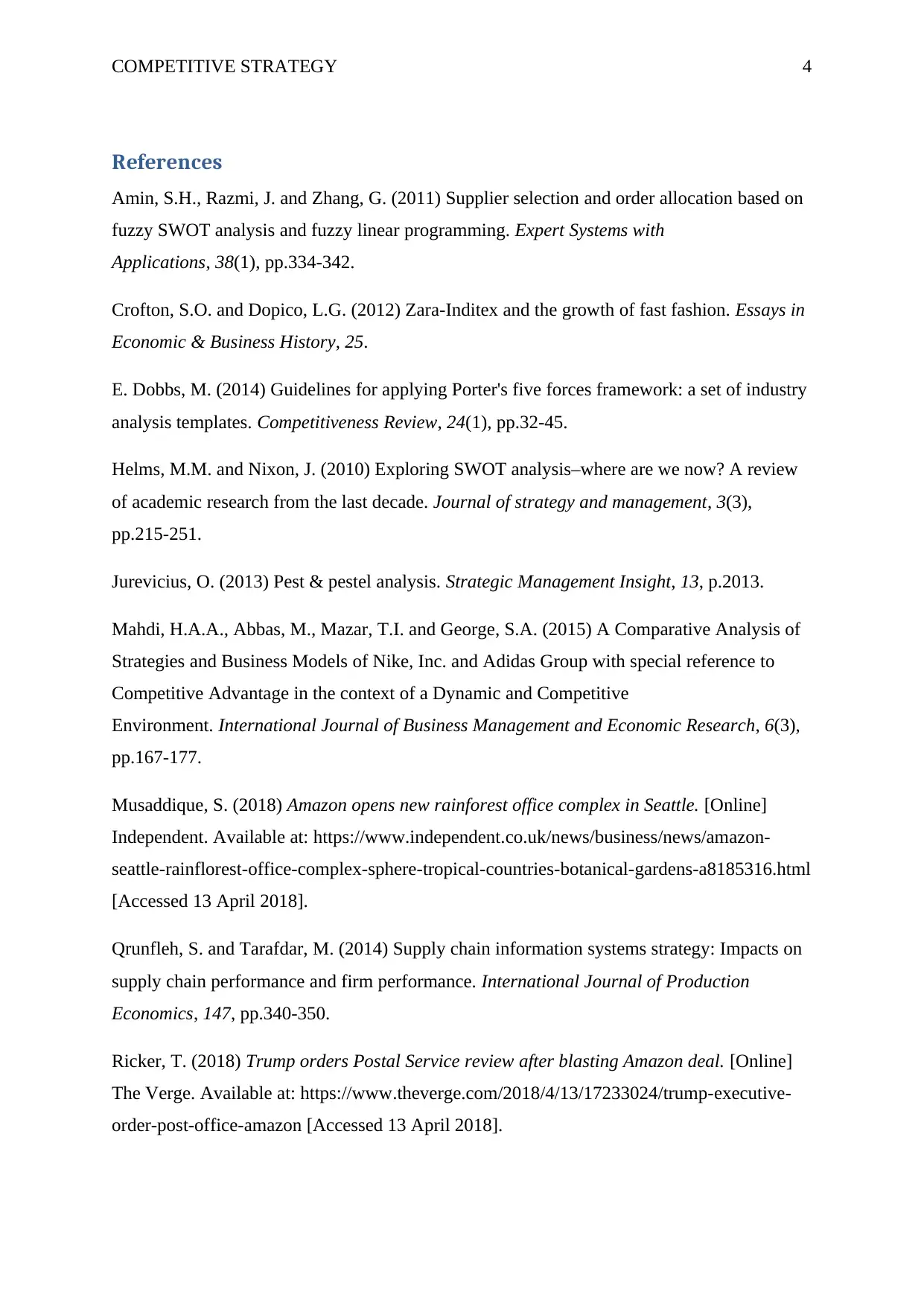
COMPETITIVE STRATEGY 4
References
Amin, S.H., Razmi, J. and Zhang, G. (2011) Supplier selection and order allocation based on
fuzzy SWOT analysis and fuzzy linear programming. Expert Systems with
Applications, 38(1), pp.334-342.
Crofton, S.O. and Dopico, L.G. (2012) Zara-Inditex and the growth of fast fashion. Essays in
Economic & Business History, 25.
E. Dobbs, M. (2014) Guidelines for applying Porter's five forces framework: a set of industry
analysis templates. Competitiveness Review, 24(1), pp.32-45.
Helms, M.M. and Nixon, J. (2010) Exploring SWOT analysis–where are we now? A review
of academic research from the last decade. Journal of strategy and management, 3(3),
pp.215-251.
Jurevicius, O. (2013) Pest & pestel analysis. Strategic Management Insight, 13, p.2013.
Mahdi, H.A.A., Abbas, M., Mazar, T.I. and George, S.A. (2015) A Comparative Analysis of
Strategies and Business Models of Nike, Inc. and Adidas Group with special reference to
Competitive Advantage in the context of a Dynamic and Competitive
Environment. International Journal of Business Management and Economic Research, 6(3),
pp.167-177.
Musaddique, S. (2018) Amazon opens new rainforest office complex in Seattle. [Online]
Independent. Available at: https://www.independent.co.uk/news/business/news/amazon-
seattle-rainflorest-office-complex-sphere-tropical-countries-botanical-gardens-a8185316.html
[Accessed 13 April 2018].
Qrunfleh, S. and Tarafdar, M. (2014) Supply chain information systems strategy: Impacts on
supply chain performance and firm performance. International Journal of Production
Economics, 147, pp.340-350.
Ricker, T. (2018) Trump orders Postal Service review after blasting Amazon deal. [Online]
The Verge. Available at: https://www.theverge.com/2018/4/13/17233024/trump-executive-
order-post-office-amazon [Accessed 13 April 2018].
References
Amin, S.H., Razmi, J. and Zhang, G. (2011) Supplier selection and order allocation based on
fuzzy SWOT analysis and fuzzy linear programming. Expert Systems with
Applications, 38(1), pp.334-342.
Crofton, S.O. and Dopico, L.G. (2012) Zara-Inditex and the growth of fast fashion. Essays in
Economic & Business History, 25.
E. Dobbs, M. (2014) Guidelines for applying Porter's five forces framework: a set of industry
analysis templates. Competitiveness Review, 24(1), pp.32-45.
Helms, M.M. and Nixon, J. (2010) Exploring SWOT analysis–where are we now? A review
of academic research from the last decade. Journal of strategy and management, 3(3),
pp.215-251.
Jurevicius, O. (2013) Pest & pestel analysis. Strategic Management Insight, 13, p.2013.
Mahdi, H.A.A., Abbas, M., Mazar, T.I. and George, S.A. (2015) A Comparative Analysis of
Strategies and Business Models of Nike, Inc. and Adidas Group with special reference to
Competitive Advantage in the context of a Dynamic and Competitive
Environment. International Journal of Business Management and Economic Research, 6(3),
pp.167-177.
Musaddique, S. (2018) Amazon opens new rainforest office complex in Seattle. [Online]
Independent. Available at: https://www.independent.co.uk/news/business/news/amazon-
seattle-rainflorest-office-complex-sphere-tropical-countries-botanical-gardens-a8185316.html
[Accessed 13 April 2018].
Qrunfleh, S. and Tarafdar, M. (2014) Supply chain information systems strategy: Impacts on
supply chain performance and firm performance. International Journal of Production
Economics, 147, pp.340-350.
Ricker, T. (2018) Trump orders Postal Service review after blasting Amazon deal. [Online]
The Verge. Available at: https://www.theverge.com/2018/4/13/17233024/trump-executive-
order-post-office-amazon [Accessed 13 April 2018].
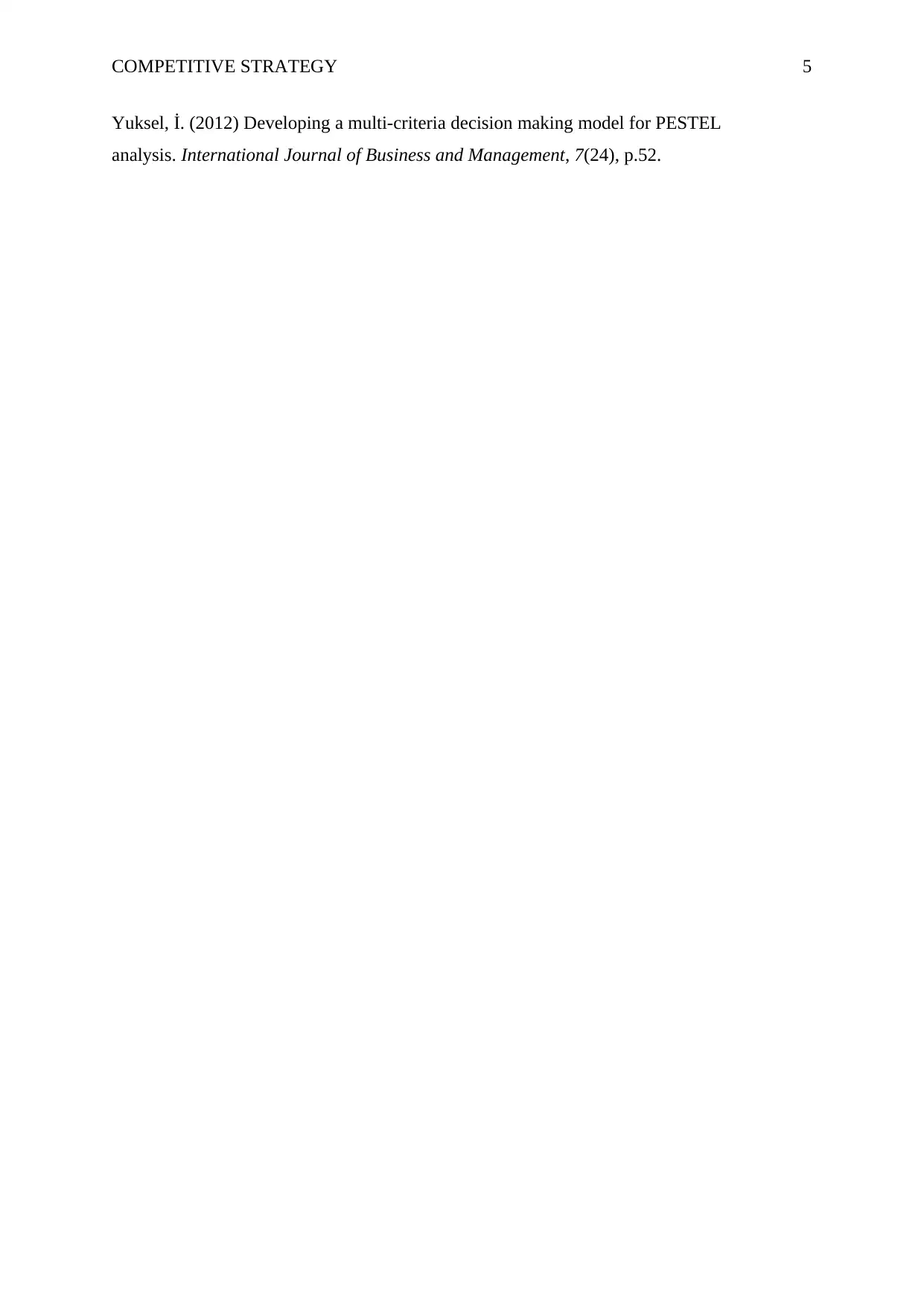
COMPETITIVE STRATEGY 5
Yuksel, İ. (2012) Developing a multi-criteria decision making model for PESTEL
analysis. International Journal of Business and Management, 7(24), p.52.
Yuksel, İ. (2012) Developing a multi-criteria decision making model for PESTEL
analysis. International Journal of Business and Management, 7(24), p.52.
⊘ This is a preview!⊘
Do you want full access?
Subscribe today to unlock all pages.

Trusted by 1+ million students worldwide
1 out of 6
Related Documents
Your All-in-One AI-Powered Toolkit for Academic Success.
+13062052269
info@desklib.com
Available 24*7 on WhatsApp / Email
![[object Object]](/_next/static/media/star-bottom.7253800d.svg)
Unlock your academic potential
Copyright © 2020–2025 A2Z Services. All Rights Reserved. Developed and managed by ZUCOL.





